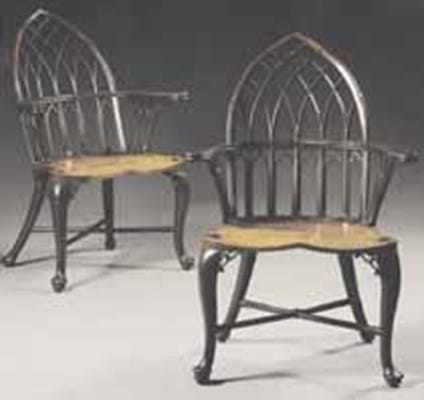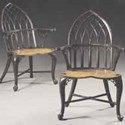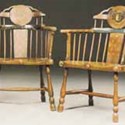Far from being modest and solely practical, the gothic-style George III armchairs, pictured right, to be offered at Sotheby's (20/12% buyer's premium) Important English Furniture sale on June 30 are exceptionally sophisticated. They have fine vaulted tracery backs, instead of the usual triple splats found on most gothic Windsors. They are also made of laburnum, whereas the vast majority of these types of chairs are in yew. This particular pair was resident in Keir House until 1983 and, as the catalogue entry implies, may have been manufactured in Scotland using the highly-prized regional laburnum found north of the border. They are expected to make £60,000-80,000.
Not to be outdone, Christie's (19.5/12% buyer's premium)Important English Furniture sale on July 1 also includes a pair of fine George III Windsors, pictured below right. They are painted with the arms of John Perceval, second Earl of Egmont (1711-1770) impaling those of his second wife, Catherine Crompton. With the date 1756 painted in Roman numerals, they would appear to mark the occasion of their marriage.
An identical chair is held in the V&A. This Windsor was once thought to be unique, but another Perceval-Compton chair emerged out of the blue at Brightwell's in Leominster last year and sold for £19,000 (plus 15% buyer's premium).
It has now been discovered that the armchairs formed part of a set of eight that were sold as two separate lots at the auction held at the former Perceval family seat of Enmore Castle, Somerset in March 1899. The Christie's pair have been consigned by a descendant of a buyer at this sale, Mrs Notley of Combe Sydenham Hall, Somerset.
These chairs, with their faceted spindles in the back, appear to be have been made in the West Country, possibly Bristol. The spindles seem to have been cut with a draw knife rather than turned on a lathe. It is most likely that they were made from beech, walnut and elm, although the use of sycamore was not uncommon in West Country chairs of this period. One leg and one stretcher have been replaced to one of the pair. They are estimated at £15,000-25,000.
PREVIEW
IT was amongst the shaded woodland of the Thames Valley that Windsor chairs are thought to have originated. The forerunners of their kind may have been merely a humble form of seating, but, as two lots in forthcoming English furniture sales show, it wasn’t long before the form began to branch out.








